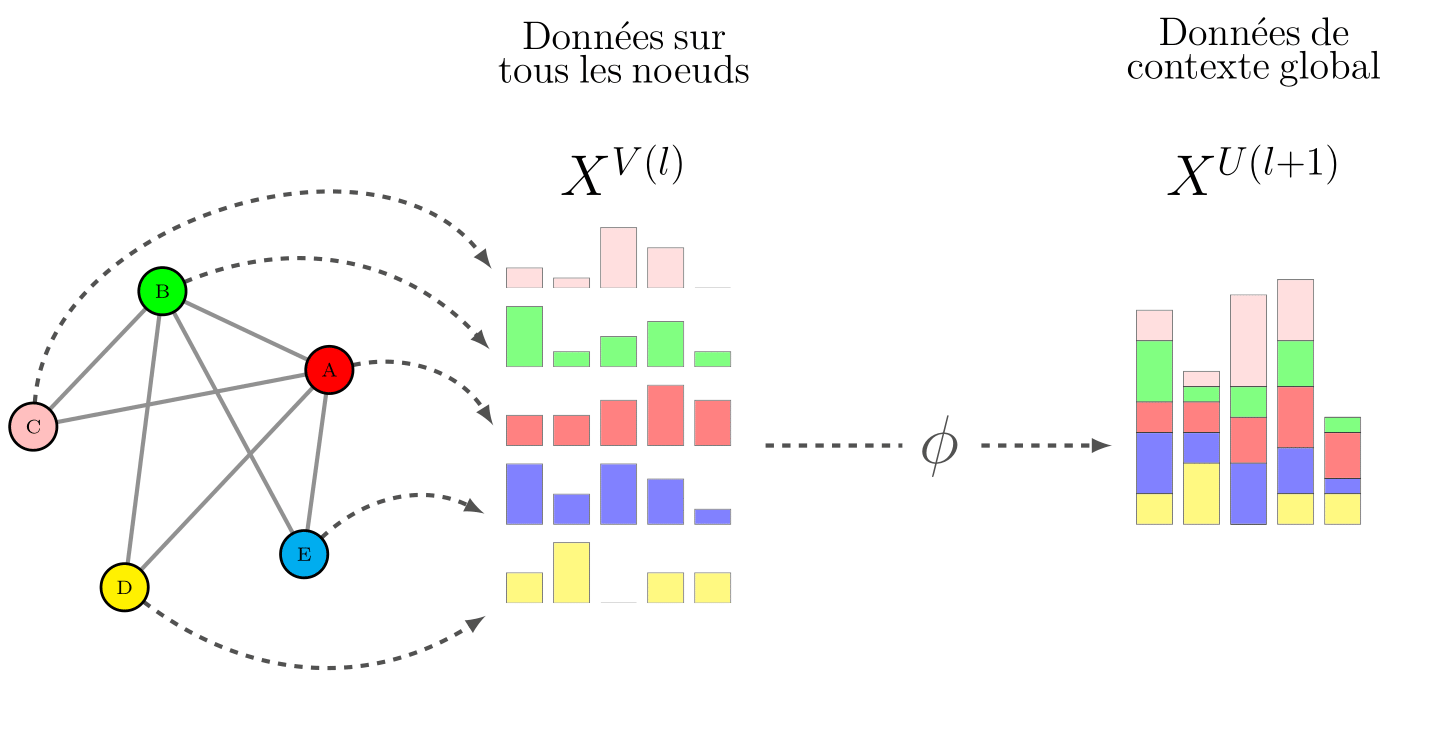Pooling nodes
Node pooling operation, also known as node feature aggregation.

\documentclass[border=3pt,tikz]{standalone}
\usepackage{amsmath}
\usepackage[dvipsnames]{xcolor}
\usepackage{pgfplots}
\definecolor{taupegray}{rgb}{0.55, 0.52, 0.54}
\def\general_height{0.2}
\usepackage{tikz-network}
\begin{document}
\begin{tikzpicture}
%\Text[x=-0.18,y=3cm]{\Large Couche $N$}
%\Text[x=14cm,y=3cm]{\Large Couche $N+1$}
\begin{scope}[scale=2]
\Vertex[x=0.88,y=0.48,label=A,color=red]{A}
\Vertex[x=-0.18,y=0.98,label=B,color=green]{B}
\Vertex[x=-1,y=0.12,label=C,color=pink]{C}
\Vertex[x=-0.42,y=-0.9,label=D,color=yellow]{D}
\Vertex[x=0.72,y=-0.69,label=E,color=cyan]{E}
\Edge[color=gray](A)(B)
\Edge[color=gray](A)(C)
\Edge[color=gray](A)(D)
\Edge[color=gray](A)(E)
\Edge[color=gray](B)(C)
\Edge[color=gray](B)(D)
\Edge[color=gray](B)(E)
\end{scope}
\begin{scope}[xshift=4cm]
\node[] at (1.5cm,3.5cm) {\huge $X^{V(l)}$};
\node[align = center, text width=5cm] at (1.5cm,5cm) {\Large Données sur tous les noeuds};
\Vertex[x=0,y=2,Pseudo]{bar_C}
\begin{axis}[ybar stacked,
yshift = 2cm,
height=\general_height\textwidth,
bar width=13pt,ymin=0,
x=17pt,
ytick=\empty,
xtick=\empty,
hide axis]
\addplot[fill=pink,opacity=0.5] coordinates
{(0,0.1) (1,0.05) (2,0.3) (3,0.2) (4,0.0)};
\end{axis}
\Vertex[x=0,y=0,Pseudo]{K}
\begin{axis}[ybar stacked,
height=\general_height\textwidth,
bar width=13pt,ymin=0,
x=17pt,
ytick=\empty,
xtick=\empty,
hide axis]
\addplot[fill=red,opacity=0.5] coordinates
{(0,0.1) (1,0.1) (2,0.15) (3,0.2) (4,0.15)};
\end{axis}
\Vertex[x=0,y=1,Pseudo]{L}
\begin{axis}[ybar stacked,
yshift = 1cm,
height=\general_height\textwidth,
bar width=13pt,ymin=0,
x=17pt,
ytick=\empty,
xtick=\empty,
hide axis]
\addplot[fill=green,opacity=0.5] coordinates
{(0,0.2) (1,0.05) (2,0.1) (3,0.15) (4,0.05)};
\end{axis}
\Vertex[x=0,y=-1,Pseudo]{bar_E}
\begin{axis}[ybar stacked,
yshift = -1cm,
height=\general_height\textwidth,
bar width=13pt,ymin=0,
x=17pt,
ytick=\empty,
xtick=\empty,
hide axis]
\addplot[fill=blue,opacity=0.5] coordinates
{(0,0.2) (1,0.1) (2,0.2) (3,0.15) (4,0.05)};
\end{axis}
\Vertex[x=0,y=-2,Pseudo]{M}
\begin{axis}[ybar stacked,
yshift = -2cm,
height=\general_height\textwidth,
bar width=13pt,ymin=0,
x=17pt,
ytick=\empty,
xtick=\empty,
hide axis]
\addplot[fill=yellow,opacity=0.5] coordinates
{(0,0.1) (1,0.2) (2,0) (3,0.1) (4,0.1)};
\end{axis}
%\draw (0,-2.5cm) -- (3,-2.5cm);
%\Text[x=3.5,y=-2.5cm]{\Huge $\mathbf{+}$}
\Vertex[x=3,y=0,Pseudo]{barplots}
\end{scope}
\begin{scope}[xshift=12cm]
\node[] at (1.5cm,3.5cm) {\huge $X^{U(l+1)}$};
\node[align = center, text width=4cm] at (1.5cm,5cm) {\Large Données de contexte global};
\Vertex[x=0,y=0,Pseudo]{agregation}
\begin{axis}[ybar stacked,
height= 5cm,
yshift = -1cm,
bar width=13pt,ymin=0,
x=17pt,
ytick=\empty,
xtick=\empty,
hide axis]
\addplot[fill=yellow,opacity=0.5] coordinates
{(0,0.1) (1,0.2) (2,0) (3,0.1) (4,0.1)};
\addplot[fill=blue,opacity=0.5] coordinates
{(0,0.2) (1,0.1) (2,0.2) (3,0.15) (4,0.05)};
\addplot[fill=red,opacity=0.5] coordinates
{(0,0.1) (1,0.1) (2,0.15) (3,0.2) (4,0.15)};
\addplot[fill=green,opacity=0.5] coordinates
{(0,0.2) (1,0.05) (2,0.1) (3,0.15) (4,0.05)};
\addplot[fill=pink,opacity=0.5] coordinates
{(0,0.1) (1,0.05) (2,0.3) (3,0.2) (4,0.0)};
\end{axis}
\Vertex[x=3,y=-3.5,Pseudo]{N}
\end{scope}
%\node[align=center,text width=5cm] at (1,-4.5) {\large Agrégation des données des noeuds voisins};
\Edge[bend=35,style={dashed},Direct](A)(K)
\Edge[bend=35,style={dashed},Direct](B)(L)
\Edge[bend=-35,style={dashed},Direct](D)(M)
\Edge[bend=70,style={dashed},Direct](C)(bar_C)
\Edge[bend=35,style={dashed},Direct](E)(bar_E)
\Edge[style={dashed},Direct,label={\Huge $\phi$}](barplots)(agregation)
\end{tikzpicture}
\end{document}